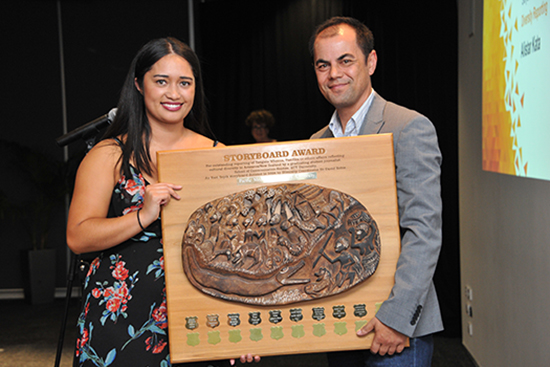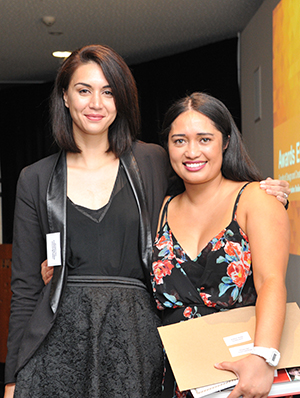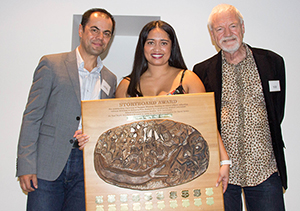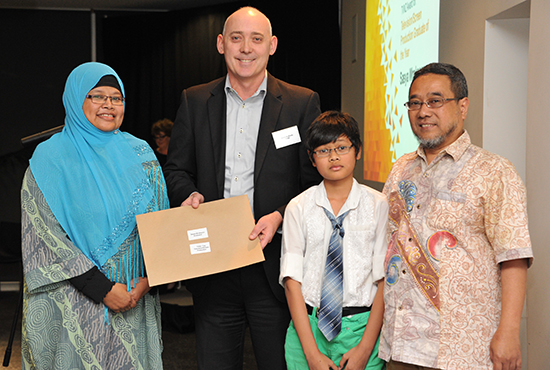
A student who was part of the award-winning team covering the Fiji elections last September picked up a rare award double at the AUT University's School of Communications 2014 media awards last night.
Alistar Kata won two awards - the Spasifik Magazine Prize and Storyboard Award for diversity reporting, and also the Radio New Zealand International Award for Asia-Pacific journalism.
The awards recognise her work in reporting on diversity, especially issues in the Pacific.
Kata thanked the Pacific Media Centre’s director Professor David Robie for sending her off to Fiji, where she covered video stories of the Fiji elections for both Wansolwara newspaper and Pacific Scoop, and her family for their love and support.
She was part of a three-member student team who won the Ossie Award for Best Use of Convergent Media last November for their Fiji coverage.
“I am especially honoured to get this award because we sometimes lack diversity reporting in mainstream media, and it is something that we absolutely need more of,” Kata said about the Storyboard.
‘Engaging stories’
She said it was great to be in Fiji, “engaging with people and their issues, and I was able to tell their stories the way that they wanted them to be told.”
Dr Robie said: “Alistar did a really tremendous portfolio of stories on diversity right through her Asia-Pacific course, but also her general reporting about Fiji and West Papua.
“It was a whole range of really well-balanced and well-researched stories.”
Innes Logan, founder and editor of Spasifik magazine, who presented the Spasifik prize and Diversity award, says recognising excellence in reporting on diversity in New Zealand is very important.
“We are in a region where a lot of Pacific stuff is happening.
“Our primary audience for Spasifik is for Pacific people but I really want to use it as a window for others so they can get some insight into what we are like - our views and our ways.”
 Leilani Momoisea of Radio New Zealand International, herself a former AUT radio graduate, presented the Asia-Pacific Journalism award, a prize she said was “dear to our hearts”.
Leilani Momoisea of Radio New Zealand International, herself a former AUT radio graduate, presented the Asia-Pacific Journalism award, a prize she said was “dear to our hearts”.
‘Hardworking’ videographer
AUT graduate Sasya Wreksono also joined the doubles party, picking up both the TV3 Award for Excellence in Practical Production and the TVNZ Award for Television/Screen Production Graduate of the Year.
Wreksono is currently filming in Indonesia and could not attend the awards, but her parents and younger brother, Dio, were there on her behalf.
Speaking on behalf of his daughter, Sony Ambudi said: “Film is an amazing medium, with which she hopes to evoke emotions and inspire others.”
He added that the award would push her even harder to pursue her passion.
Her mother, Hanny Savitri Hartono, said they were all really proud of her.
“We don’t have to push her to do her best; she always strives for her best,” she added.
She says her background as an Indonesian and Muslim girl influenced her stories, giving perspectives and experiences Muslim women had with and without hijab.
 Wreksono’s final project supervisor, senior lecturer Eileen Lavranos said: “She was a very good student, very creative, and she should have a good career.
Wreksono’s final project supervisor, senior lecturer Eileen Lavranos said: “She was a very good student, very creative, and she should have a good career.
“She was interested in her own culture and background, about struggling with cultural identity, and wanted to highlight issues with how to fit in.”
‘Messy scene’
Trish Carter, founding editor and bureau chief for Al Jazeera English in the Asia-Pacific region, hosted the awards evening, and had plenty of advice for AUT’s future media practitioners.
She said New Zealand needed a well-informed population now more than ever, and that was why journalism was so fundamentally important.
 She said she was pleased to be in New Zealand at a time when there is a big media debate, referring to the Campbell Live controversy.
She said she was pleased to be in New Zealand at a time when there is a big media debate, referring to the Campbell Live controversy.
“You [AUT students] are the ones who will ultimately hold the key to that debate. The challenges are immense, but if you get it right, so are the rewards.”
She said it would be a wasted opportunity if something did not come from this debate.
“Our ambition has to be beyond Campbell Live,” she said.
She said it was a “messy scene” ahead for AUT’s aspiring journalists, with static or shrinking news audiences and revenue, demographics changing, and new forms of media.
“It’s hard to imagine that the new forms of media that are in ascendency won’t mutate far more quickly in the future… I can’t wait to see how you are all going to do that.”
Full AUT Communication Studies awards list



This work is licensed under a Creative Commons Attribution-NonCommercial 3.0 New Zealand Licence.




